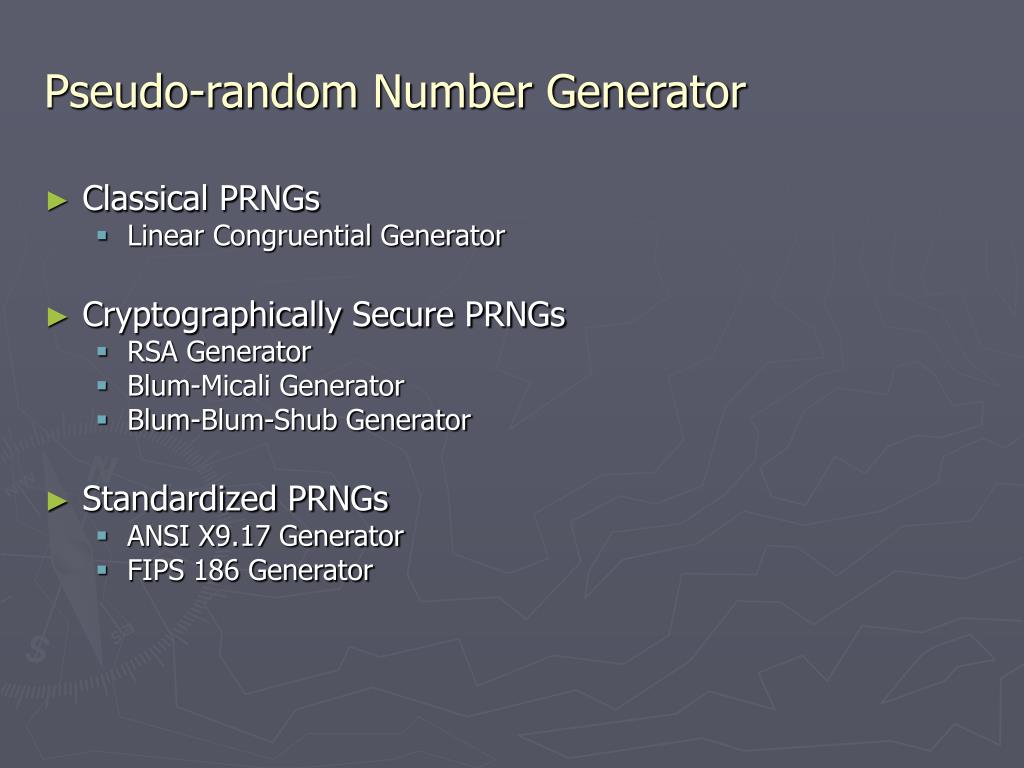
- #MOST COMMON PSEUDO RANDOM NUMBER GENERATOR ALGORITHM GENERATOR#
- #MOST COMMON PSEUDO RANDOM NUMBER GENERATOR ALGORITHM SERIES#
Note that at most, m distinct Z i ’s and thus r i’s (pseudo-random numbers) can be obtained.
#MOST COMMON PSEUDO RANDOM NUMBER GENERATOR ALGORITHM GENERATOR#
The generator is recursive that is Z i is a function of Z i-1. Fortunately for our purposes, values for the parameters (a, c, m, and Z 0) that result in the desirable properties listed above are used by commercial simulation languages. The pseudo-random number r i is obtained by dividing Z i by m. Other parameters of the generator are a multiplier a, an increment c, and the first integer Z 0. The integer Z i is a remainder and m is the divisor. The Z i ’s are a set of integers that range from 0 to m-1. The linear congruential generator (LCG) has the form: Perhaps the most common type of pseudo-random number generation algorithm, with respect to use in simulation languages, is the linear congruential generator (Lehmer, 1951). Schmeiser (1980) provides a comprehensive survey. Other approaches for generating pseudo-random numbers are given in Banks, Carson, Nelson, and Nicol (2009) as well as Law (2007). This means for example that if the probability distribution modeling the operation time at station A were changed, the times between arrivals would remain the same.Īs in the previous section, one approach to pseudo-random number generation will be presented.
#MOST COMMON PSEUDO RANDOM NUMBER GENERATOR ALGORITHM SERIES#
For example in the two stations in a series model, the time between arrivals and the operation time at station A would be assigned different streams. Having multiple streams of random numbers allows sampling from each particular probability distribution used in a model to be associated with a particular stream. Imagine the difficulty of removing a bug from a model if the results were randomly different each time the model was executed!Ī sequence of pseudo-random numbers is called a stream. This is important in simulation both for debugging and experimentation using common random numbers. All possible numbers in the sequence are generated before any number repeats.īecause the pseudo-random number generation algorithms are deterministic, a sequence of numbers can be regenerated whenever necessary.

There are many, many (at least 1,000,000) numbers in sequence.The numbers appear to be uniformly distributed in the range (0,1).The numbers do not exhibit any statistical correlation with each other.However, the properties of the sequence of pseudo-random numbers make them look random. Fortunately, there are several well known algorithms for generating such samples, called pseudo - random numbers. All of the random sampling strategies discussed in the previous section require a random sample uniformly distributed in the range (0,1).


 0 kommentar(er)
0 kommentar(er)
